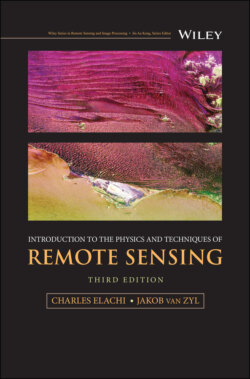Читать книгу Introduction to the Physics and Techniques of Remote Sensing - Jakob J. van Zyl - Страница 26
2.1.8 Doppler Effect
ОглавлениеIf the relative distance between a source radiating at a fixed frequency ν and an observer varies, the signal received by the observer will have a frequency ν′, which is different than ν. The difference, νd = ν ′ − ν, is called the Doppler shift. If the source–observer distance is decreasing, the frequency received is higher than the frequency transmitted, leading to a positive Doppler shift (νd > 0). If the source–observer distance is increasing, the reverse effect occurs (i.e., νd < 0) and the Doppler shift is negative.
Figure 2.6 Group velocity.
The relationship between νd and ν is
(2.29)
where υ is the relative speed between the source and the observer, c is the velocity of light, and θ is the angle between the direction of motion and the line connecting the source and the observer (see Fig. 2.7). The above expression assumes no relativistic effects (υ ≪ c), and it can be derived in the following simple way.
Referring to Figure 2.8, assume an observer is moving at a velocity υ with an angle θ relative to the line of propagation of the wave. The lines of constant wave amplitude are separated by the distance λ (i.e., wavelength) and are moving at velocity c. For the observer, the apparent frequency ν′ is equal to the inverse of the time period T′ that it takes the observer to cross two successive equiamplitude lines. This is given by the expression
(2.30)
which can be written as
(2.31)
The Doppler effect also occurs when the source and observer are fixed relative to each other but the scattering or reflecting object is moving (see Fig. 2.9). In this case, the Doppler shift is given by
(2.32)
Figure 2.7 Doppler geometry for a moving source, fixed observer.
Figure 2.8 Geometry illustrating wave fronts passing by a moving observer.
Figure 2.9 Doppler geometry for a moving scatterer with fixed source and observer.
and if the source and observer are collocated (i.e., θ1 = θ2 = θ), then
(2.33)
The Doppler effect is used in remote sensing to measure target motion. It is also the basic physical effect used in synthetic aperture imaging radars to achieve very high resolution imaging.
